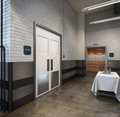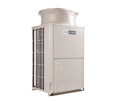Hospitality and Retail Design Update
Energy-Efficient Cooling and Heating Delivers Comfort
Keeping hospitality guests and retail shoppers comfortable while controlling energy usage is a daily challenge for all who design, construct, or operate these spaces. The traditional way to do that is with a combination of central HVAC units and ductwork that delivers appropriately cooled or heated air to individual spaces. A different approach that is being successfully applied in hotels, restaurants, and stores is a variable refrigerant flow (VRF) zoning system. These systems use a central outdoor unit that supplies conditioned refrigerant to individual, zoned indoor air-handling units that use only the amount of refrigerant required to cool or heat a space. With VRF systems, design and installation tend to be easier and faster, while fewer materials are needed since there is no need to install ductwork—refrigerant is piped directly to an air-handling unit in a specific space. The compact footprint results in more usable (leasable) space and higher ceiling heights due to reduced plenum space requirements. With a variable speed compressor, refrigerant flow and compressor speed is increased with demand and decreased when demand is lower. This results in lower operating costs with VRF systems versus traditional HVAC systems. While the upfront equipment costs for VRF may be higher than traditional equipment, when the systems are evaluated on a total installed cost basis, the pricing is more comparable.
VRF zoning systems can meet the needs of an entire building and can be customized to meet the particular needs of just about any type of retail or hospitality building. Controls are available that allow for remote management of the systems and can integrate with other building system controls. Although somewhat modular and separated in nature, VRF systems are appropriate for entire buildings, whether new construction or renovation. The individual room or space zoning allows different areas of the building to be kept at different temperatures and gives occupants the ability to control their own comfort. VRF systems are also easily modified as the needs of a building or its occupants change.
From an operations and maintenance standpoint, VRF systems offer a lot of advantages as well. The latest compressor technology is typically used, which is highly efficient and uses only the precise amount of energy required to maintain occupant comfort. Further, they are inherently low-maintenance systems that are easy to service and do not require the entire system to be taken offline to service one zone. Hence, if a particular zone needs attention, it can be isolated and addressed while the rest of the building continues to operate smoothly.
The systems are also quieter than traditional HVAC systems and have been shown to satisfy users, particularly hotel guests. A seasoned traveler, Dennis Hertlein, a partner with the firm of Surber Barber Choate & Hertlein, in Atlanta, Georgia, has openly remarked that “Because of the super quiet VRF system with filtered air and outstanding indoor air quality, I had the best night’s sleep in a hotel I’ve ever had and woke up feeling great.” Given all of these attributes and positive capabilities, they are well worth considering.

Photos courtesy of Mitsubishi Electric Cooling & Heating
Variable refrigerant flow (VRF) zoning systems use centrally cooled or heated refrigerant run to individually zoned spaces based on the demand for space cooling or heating.
Notice

www.amerlux.com

www.mockett.com/levity

www.hawa.com

www.inprocorp.com/ipc

MitsubishiPro.com/ready/innovation

www.nanawall.com/applications/commercial

www.pellacommercial.com/monumental-windows

www.hooksandlattice.com/custom-marek-planters.html









